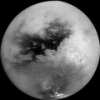Titan is the largest of Saturn's moons with a diameter of 5,152 km (3,200 miles). It orbits in a near circular orbit with a radius of 1,221,870 km (759,000 miles), completing one orbit in about 15 days and 22 hours. It has a surface of water ice, comprising about half of the moon's volume, over a silicate core about 3,400 km (2,100 miles) across.
Like earth's Moon, Titan's rotation is synchronous with its orbit, so it always shows the same face to Saturn. Titan is in a 3:4 orbital resonance with Hyperion; that is, for every three orbits Hyperion makes, Titan makes four.
Apart from the earth, Titan is the only body in the Solar System known to have large areas of liquid on the surface as lakes or seas, although these comprise hydrocarbons like liquid methane and ethane rather than water.
Titan has a dense, nitrogen-rich atmosphere with a surface pressure about 1.45 times that of Earth's. The upper atmospheric (stratosphere) comprises 98.4% nitrogen, 1.4% methane, with most of the remainder being hydrogen. This abundance of methane in the atmosphere can not be explained by the amount on the surface. There are many volcanoes on Titan, though the magma they spew out is a water and ammonia mixture, together with methane, which replenishes the atmospheric content. These are known as cryovolcanoes, or ice volcanoes. As soon as the material is ejected, it starts to cool and solidify in the extreme cold on Titan.
Like earth's Moon, Titan's rotation is synchronous with its orbit, so it always shows the same face to Saturn. Titan is in a 3:4 orbital resonance with Hyperion; that is, for every three orbits Hyperion makes, Titan makes four.
Apart from the earth, Titan is the only body in the Solar System known to have large areas of liquid on the surface as lakes or seas, although these comprise hydrocarbons like liquid methane and ethane rather than water.
Titan has a dense, nitrogen-rich atmosphere with a surface pressure about 1.45 times that of Earth's. The upper atmospheric (stratosphere) comprises 98.4% nitrogen, 1.4% methane, with most of the remainder being hydrogen. This abundance of methane in the atmosphere can not be explained by the amount on the surface. There are many volcanoes on Titan, though the magma they spew out is a water and ammonia mixture, together with methane, which replenishes the atmospheric content. These are known as cryovolcanoes, or ice volcanoes. As soon as the material is ejected, it starts to cool and solidify in the extreme cold on Titan.
Titan
Solar System -
Saturn's Moons
A wonderful photograph of Titan's surface taken on 14th January 2005 by the Hyugens lander, launched from the Cassini probe. It is a true color image.
The first is a combination of images taken through three filters that are sensitive to red, green and violet light. It shows approximately what Titan would look like to the human eye. The orange color is due to the hydrocarbon particles which make up Titan's atmosphere.
The second image uses near-infrared light to see through the hazy atmosphere and down to the surface. The view was created by combining three separate images taken with this filter, in order to improve the visibility of surface features. The variations in brightness on the surface are real differences in the reflectivity of the materials on Titan.
The third is a false-color composite created by combining two images taken at different infrared wavelengths (938 and 889 nanometers) with a visible light image (taken at 420 nanometers). Green represents areas where Cassini is able to see down to the surface. Red represents areas high in Titan's stratosphere where atmospheric methane is absorbing sunlight. Blue along the moon’s outer edge represents visible violet wavelengths at which the upper atmosphere and detached hazes are better seen.
The second image uses near-infrared light to see through the hazy atmosphere and down to the surface. The view was created by combining three separate images taken with this filter, in order to improve the visibility of surface features. The variations in brightness on the surface are real differences in the reflectivity of the materials on Titan.
The third is a false-color composite created by combining two images taken at different infrared wavelengths (938 and 889 nanometers) with a visible light image (taken at 420 nanometers). Green represents areas where Cassini is able to see down to the surface. Red represents areas high in Titan's stratosphere where atmospheric methane is absorbing sunlight. Blue along the moon’s outer edge represents visible violet wavelengths at which the upper atmosphere and detached hazes are better seen.
Credit: ESA/NASA/JPL/
Univ of Arizona
Univ of Arizona
16 separate photographs, taken by Cassini during a flyby in 2005, were combined to create this image. The large dark region you can see is called Shangri-la.
Saturn's moons are grouped as follows. Select to see details of the moon or the group of moons:
Mimas • Enceladus • Tethys • Dione • Rhea • Titan • Iapetus • Hyperion • Norse Grp • Shepherd Moons • Alkyonides • Inuit Grp • Gallic Grp • Misc
Three views of Titan using different wavelengths of light. Click image for larger picture.
A cutaway image of Titan's interior.





